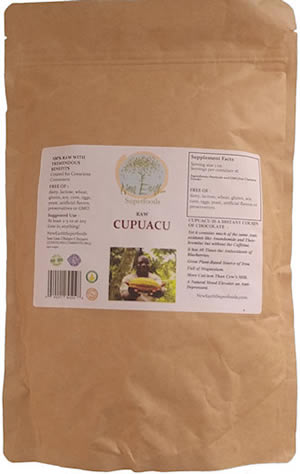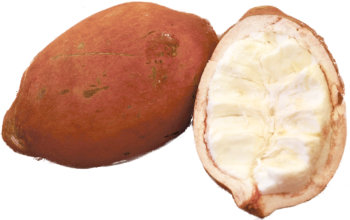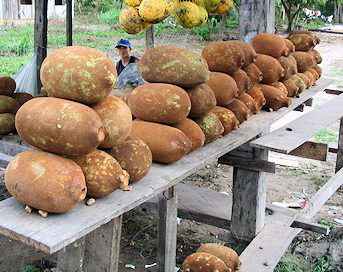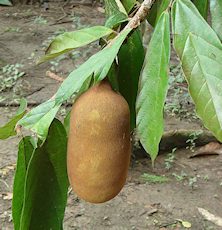

Cupuacu (pronounced coo pooh a sooh) is thought of by locals in the Amazon river basin as a "Pharmacy in a Fruit" - for them it's the goto solution for stomach complaints and tiredness.
What Cupuaci Powder Is:
Our Pesticide and GMO Free Cupuacu fruit powder is a lyophilized (freeze dried) powder obtained from the juiced, white flesh of freshly picked Cupuacu fruit. It is packaged in one pound bags. Each 1/2 tablespoon serving (60 servings per bag) of Cupuacu powder is equivalent to five ounces of Cupuacu juice.

Why You Should Be Consuming Cupuacu Powder:
You should be eating Cupuacu powder for the minerals it provides (drawn from fertile Amazon soils), and more especially for the considerable amounts of vitamins and polyphenol antioxidants, especially theograndins, which are potent free radical scavengers that help protect cells against pollutants, herbicides and other toxins. It is known for quickly helping with stomach distress.
Cupuacu has an interesting and delightful taste (in between coconut, pineapple, mango, anise, banana and chocolate) that most people learn to absolutely LOVE. You won't know whether to eat it by the spoonful or add it to beverages. With more antioxidants pound for pound than Acai berries, Cupuacu is destined to become South America's greatest antioxidant treasure.
The Cupuacu fruit grows on Cupuacu trees. The Cupuaçu tree belongs to the cacoa family and grows to a height of 12-20 meters (30-65 feet). The fruit of the tree has a creamy, exotic pulp at the center of a large melon and has been a primary food source for natives in the rain forest for centuries.
Cupuacu is just beginning to be recognized internationally as a nutrient powerhouse.
Cupuacu is recognized by them as one of the most nutritious foods that grows in the Amazonian flood plains. However, the Cupuacu fruit is just beginning to be recognized internationally. Watch the videos about Cupuacu below and see more about its nutrient profile in the next section.
Freeze-drying Cupuacu fruit increases its nutrient density by 20 times. Incorporating Cupuacu powder into any nutritional beverage is a tasty, smart habit. Just add a tablespoons to a glass of water, milk, protein shake, bowl of cereal, etc., or eat it by the spoonful.
The Nutrients in Cupuacu:
Almost alone in the plant world, Cupuacu fruit contains a large amount of theograndins (extremely anti-oxidizing and detoxifying type of sulfated polyphenols). Cupuacu's sulfated polyphenols have a myriad of folkloric, as well as, scientifically-validated, nutritional benefits, which will be discussed elsewhere.
Our Pesticide and GMO Free Cupuacu powder is additonally heavily endowed with:
- vitamins B1, B2, B3
- minerals
- fatty acids
- amino acids
- and at least nine antioxidants (including Selenium, Vitamins A and C)
- It also has a high flavonoid content.
Large Amounts of Sulfated Polyphenols in Cupuacu:
Cupuacu contains an extremely rich concentration of sulfated polyphenol antioxidants. These sulfur-rich antioxidants appear to have a large number of longer-term good effects on the body including the neutralization of free radicals and the formation and repair of tissue throughout the body. They have been shown to improve gastrointestinal system functioning (explaining the fruit’s traditional use by natives for GI problems), stabilize blood sugar and to generally improve cardiovascular system functioning. Cupuacu's unique sulfated polyphenol antioxidants have been shown in preliminary research to help lower cholesterol levels and improve brain function.
Because of these sulfated polyphenols, Cupuacu is revered by villagers and is often called a "Pharmacy in a Fruit", because of the many health benefits its provides and the many health challenges it is traditionally believed to heal.
Health Benefits From Eating Cupuacu:
There are many traditionally touted health benefits from eating Cupuacu. These benefits are absolutely synergistic — meaning not the result of any single nutrient, but the result of all Cupuacu's nutrients acting together like tag teams to stabilize blood sugar and mood, boost energy and physical function.
Until more scientific research is done, however, all benefits described below should be considered to be folklore, anecdotal and opinion. Further scientific research would need to be done to make reliable health benefit claims. Nevertheless, the amount of interest and perceived benefits from Cupuacu is beginning to be significant.
- A primary health benefit of Cupuacu many people ascribe to Cupuacu is in regard to supporting the immune system to improve the body’s ability to fight disease.
- Cupuacu has a (caffeine-like, although Cupuacu contains very little caffeine), energizing effect upon the mind. It is one of the few cocoa relatives that does not contain appreciable amounts of caffeine, yet it retains this energizing effect.
- Improved circulation and lowered blood pressure are traditionally mentioned by those eating Cupuacu.
- Cupuacu is traditionally considered useful for achieving healthier skin and hair
- Cupuacu is believed to help with gastrointestinal health.
- Cupuacu is regarded by locals as providing great help in maintaining healthier blood sugar and cholesterol levels (if this is true, it is most likely through lipid per-oxidation inhibition)
- Cupuacu is regarded as helpful to improve libido.
Other Cupuacu Facts

- Sold throughout the Amazonian jungle basin region, Cupuacu is the national fruit of Brazil and is prized for its good taste and health enhancing properties. It has been consumed by wise locals, for centuries.
- Cupuacu fruit may eventually eclipse Acai berries as the most popular of all the South American plants (fruits and berries) because it has the same, if not superior health benefits. Also, Cupuacu is much easier to grow without destroying rain forests (see the video about Cupuacu and rain forests below). Pound for pound it occupies less space and is a much more resource efficient crop to grow than Acai. It truly is the antioxidant super food of the future.
- Cupuacu fruit belongs to the Cocoa (chocolate) family with many of the energizing benefits of cocoa but with virtually no caffeine.
- Historically, Cupuacu fruit has been a primary food source for natives in the rain forest for a thousand years and has a creamy, exotic and nice-tasting pulp at the center of a large melon sized fruit.
You Are What You Eat — Which is Why We Recommend Cupuacu

Rishi Ternes, owner of New Earth Super Foods, left the study of medicine in Germany, came to the U.S. and turned his life over to the pursuit of nutrient dense food and seeking to understand the ability of food to transform health. He believes that “we are what we eat” and that “food should be our medicine”. Rishi owns a Super Food Cafe and Health Transformation Center in Grover Beach, California. He continues to search the world for foods that enable to the body to repair itself. As Rishi says, “the nutrients that your body needs are in the foods you aren’t eating.”
Rishi seeks out farmers and food suppliers that are progressive, meaning they are adding minerals and trace minerals to their soils, not using pesticides or GMO, and harvesting their foods at the peak of ripeness. Rishi then ensures that those foods are juiced and freeze dried immediately before nutrient loss.
Food is the way of health not vitamins!
Cupuacu fits with the “first rule of health” which is that food should be our medicine. Cupuacu also fits with our second rule of health, which is that food engenders health, not vitamins. The United States has among the worst health statistics of all industrialized nations, yet the people of the United States consume more vitamins that the rest of the world combined. That means that you will eventually find, as so many others have already found, that your health will never really start to improve until you give up on vitamins and turn to food. It's time to turn to food!
- Vitamins, IE nutrient isolates (often made in a laboratory), may look powerful and awesome on the label, but they don’t work as well in the human body as one would hope because they lack the many needed co-factors. Food comes with many needed co-factors nutrients.
- The lack of co-factors is the basic problem of vitamin supplements. Without those co-factors, they're NOT as useful to our cells. For instance, Vitamin C is not just ascorbic acid but rather it is: ascorbic acid and numerous co-factors that work in the cells like catalysts or tag teams to make chemical reactions occur. The many co-factors are present in foods, but are not in vitamin isolates. The result, therefore, of taking vitamins is that the body has to scavenge body tissues to obtain the needed co-factors, or wait until they are available or the body may simply discard the nutrients for which co-factors are not available. This is extra work and/or a waste of nutrients, and therefore, vitamin isolates, do far less to improve health than does food.
Pesticide and GMO Free Cupuacu fruit powder Ordering Form
Comparative Retail Price: $70 per pound.
Our Price: $55 per Pound
Raw Cupuacu Powder
|
||||||||||||||

How to Use:
Add any amount desired of Cupuacu powder to any drink or liquid. Normal serving size is 1/2 to 1 tablespoon.
Videos about Cupuacu
We disclaim any claims (if there are any) made in these videos. They are for information, education, enlightenment and entertainment only.
Copyright 2002 - 2024. All rights reserved.
These statements have not been evaluated by the Food and Drug Administration. No product mentioned herein is intended to diagnose, treat, cure or prevent any disease. If you are pregnant, nursing, taking medication, or have a medical condition, consult your physician before making any lifestyle change, including trying a new product or food.
The information on this website is intended as a sharing of knowledge and information from the research and experience of the Healthy-Living.Org staff and contributors. It is not intended to replace a one-on-one relationship with a qualified health care professional and it is not intended as medical advice. You should not use the information on this site for diagnosis or treatment of any health problem or for modification of any medication regimen. You should consult with a healthcare professional before starting any diet, exercise or supplementation program, before starting or discontinuing any medication, or if you suspect you have a health problem. You should keep in mind that cited references to ongoing nutritional scientific study are most likely not accepted by the FDA as conclusive. These references and mentions of benefits experienced by others are disavowed as product claims and are only included for educational value and as starting points for your own research. No food or supplement can be considered safe for all individuals. What may benefit 999,999 of a million people may harm you. Therefore, no one can take responsibility for your health except you in concert with your trusted health professional.
 Each Cupuacu tree produces about 20-30 fruits, having lengths 6 to 10 inches (15 - 25 cm) and diameters of 4 to 5 inches (10 - 12 cm) and with a weight from 1.5 to nearly 5 pounds (800g to 2 Kg) — that’s a very heavy fruit!.
Each Cupuacu tree produces about 20-30 fruits, having lengths 6 to 10 inches (15 - 25 cm) and diameters of 4 to 5 inches (10 - 12 cm) and with a weight from 1.5 to nearly 5 pounds (800g to 2 Kg) — that’s a very heavy fruit!.
